





















Germany recently allowed the restricted consumption of cannabis, but clubs that grow and share the plant say they are experiencing challenging levels of bureaucracy.
Visiting a club that grows and shares cannabis is one of the ways consumers can now access the drug since its consumption was made legal in Germany in April, albeit with restrictions.
However, applicants to set up said clubs are experiencing different levels of bureaucracy

depending on the state.
Berlin’s local government said that the city’s health department should be handling their approval, but an analysis of the costs needs to be carried out first. In the meantime, districts will take them on, in a process applicants describe as cumbersome.
The slow process is a particular hindrance for users in Berlin, which has a significantly higher cannabis use compared to the national average. A 2021 survey found that more than half of Berliners have consumed cannabis at least once.


Alex Khourdaji, an analyst with research company Prohibition Partners, said the challenges could push users to illegal sources again.
“A lot of people that were going to set up felt like that it was too bureaucratic, so they decided not to set up cannabis cultivation associations,” he said. “Now, with less cannabis cultivation association that leaves many consumers in the dark, and it does give them the attitude, or the feeling that they might have to revert back to the illicit market.”
Khourdaji added that many are turning to growing their own cannabis.
A report by Prohibition Partners stated that
creating cannabis clubs is a “time-consuming and strenuous process”.
While owning cannabis has been legalised, it has not stopped the black market, and residents can buy it illegally at parks in central Berlin.
The continued illicit selling of cannabis could play into the hands of opponents of its legalisation, eventually leading to the reversal of the law that permitted it in the first place.
The conservative Christian Democratic party (CDU), which is leading in the polls, says that undoing the law will be a priority after next year’s election.
The party said there had been a massive increase in drug related crime, but the health ministry says in response that such crime statistics are not yet available for this year.
“Legalising cannabis was a huge mistake,” wrote Tino Sorge, a CDU MP and health policy spokesman for the CDU and its sister party the Christian Social Union (CSU), in a statement.
‘The consequences for children’s and young peoples’ health cannot yet be predicted at all,” he said. “It is therefore of high priority for the CDU/CSU parliamentary group to reverse this law and to stop the harmful effects after the next elections.”
Source: EuroNews.com























Page 10
Lemon Drizzle A stunning jackpot experience

Page 13
Liriomyza: a pest under our leaves
Page 18
Sweet Zenzation the queen of the greenhouse


Page 22 Is there HLVd in Your Grow room?

Page 24
Weird Cannabis




JAYSAFE®:
Safety, discretion, and style – with JAYSAFE®, you can transport your joint cleverly and discreetly. Made from durable, lightweight aluminum, the case is not only long-lasting but also comfortable to use. Thanks to the silicone seal, everything stays odor-proof and waterproof – perfect for any situation.
The highlight is the conical silicone holder in the lid: it secures joints with all common filters (ø 1–9 mm), protects the filter from ash particles, and ensures your joint is always perfectly protected. With its minimalist, stylish design, JAYSAFE® suits any lifestyle and is the ideal companion on the go. More than just a case – a statement of quality and uncompromising functionality.
JAYSAFE® – Always safe. Always ready. www.fire-flow.eu


Dryferm is the most efficient solution for perfect harvest drying – simple, clean, space-saving, and virtually odorless. Thanks to innovative film technology, moisture escapes while active compounds like THC, CBD, and terpenes can increase by up to 100%. No prior knowledge is required: simply seal the freshly harvested flowers airtight in the bag, place it in a well-ventilated room, and let the process take care of itself. Save space, time, and money while elevating the quality and flavor of your harvest to a whole new level. With Dryferm, drying becomes revolutionary, easy, and highly effective.
www.dryferm.com
Royal Queen Seeds has been honored with the prestigious Best Cultivation Company of the Year Award for the second consecutive year at The Emjays, held during MJBiz Week in Las Vegas. This achievement highlights the brand’s exceptional dedication to excellence and innovation in the cannabis industry. Having entered the U.S. market just two years ago, Royal Queen Seeds has quickly established itself as a leader in home-growing, underscoring the untapped potential for cannabis enthusiasts across the country.
www.theemjays.com

James McDonald started The Hemp Company Dublin and Get Up and Grow in 1999 with the aim of spreading the benefits of Hemp for its unique food value, its exceptional range of applications and its stunning environmental credentials. The shop on Capel Street, in Dublin City, is a treasure trove of hemp delights while also seeking to educate about the incredible properties of this wonder plant. The Hemp Company specialises in Industrial Hemp products of every kind, most notably CBD oils, balms, cosmetics,and even clothes, all of which are sustainably produced. Today we bring you our pleasant conversation with this passionate Irish hemp advocate.
Which products do Irish people prefer?
Our own brand CBD products are top of the list, while hemp seed, a rich source of complete plant based protein, Omega 3 Fatty acids and fibre, is rapidly gaining attention as a powerhouse ingredient in the health food industry. Demand for our hemp seed oil, protein, flour, hulled seeds and de-hulled seeds ( known as hearts) is rapidly expanding.

‘HELLO HEMP’: A New Era in Nutrition is our inhouse brand with a mission to redefine perceptions of hemp food and provide the perfect solution for health conscious consumers looking for natural wholesome food to improve their overall health while limiting the negative impact on the environment.We’re truly on the cusp of consumer-driven change in global food production.

Right Bank Seeds is our long established seed brand which compliments its sister company Get Up and Grow. The interest of Irish consumers in the seed offering and in acquiring the equipment and knowledge needed to grow at home has been steadily increasing since Covid-19. We have partnered with some of the best breeders and seed suppliers to bring the best in new and existing lines to our customers. Irish people are definitely exploring self-sufficiency in a new way and our brands are positioned to take advantage of global and EU trends in hemp and associated markets.
“One of the most satisfying aspects of the business for me and my team is our ability to offer truly holistic, healthy and environmentally beneficial options for Irish and EU consumers who are ever more conscious about the global impact of their food and lifestyle choices.” www.hempcompany.ie www.getupandgrow.ie www.rightbankseeds.ie
By Markus Berger
Uncontrollable forest fires are once again raging in California, potentially causing major difficulties for the thriving cannabis industry. For example, in Los Angeles County, some licensed cannabis businesses are struggling with a variety of challenges to maintain operations during this devastating crisis. The first suppliers are also refusing to send cannabis to the affected areas. And for good reason.
According to information from the Department of Forestry and Fire Protection, more than 10,000 buildings have been destroyed in the region around Los Angeles and 13 people have already lost their lives in the fires (as of mid-January). Like many other businesses, cannabis dispensary operators in affected areas must adapt to the circumstances resulting from the fires. Fortunately, almost all cannabis retailers are located outside of the previously affected coastal areas, which is why the disaster has been mild for most entrepreneurs so far. But not for everyone.
One of the main problems that the cannabis dispensaries located near the fires have to contend with is the decision by their suppliers not to want to deliver any more goods for the time being. The reason is the completely justified fear


about the sensitive products, which are likely to be lost. The public announcement of mandatory evacuation zones forced various dispensaries, such as 99 High Tide in Malibu, but also others, to initially close their businesses completely.
The company Mammoth Distribution, which has its own brand portfolio and acts as a wholesaler of cannabis products, was lucky. Mammoth is headquartered in North Hollywood, approximately 10 miles north of the Sunset Fire that broke out in the Hollywood Hills on January 8th. Because the fire department was able to put it out a day later, the evacuation requirements were withdrawn and operations were able to continue.
A directive from the Department of Cannabis Control (DCC), the state’s top cannabis regulator, that was tailored to the fires also initially

caused problems for dispensary operators. Licensees affected by the fires should inform the DCC before moving their cannabis inventory to another location to protect them from the fires. In case of doubt, this would have cost the entrepreneurs valuable time. However, the DCC subsequently corrected the requirements and allowed the products to be moved quickly as long as they were stored in a secure location to which only the licensee and its employees and contractors have access. Only then does the DCC have to be informed about the relocation of the cannabis - and the DCC employees must also have the opportunity to enter and inspect the new storage location. License holders can
also apply for disaster relief from the authority.
The California Cannabis Industry Association (CCIA) had not received any reports of fire damage to cannabis cultivation facilities as of press time, but had learned of operational disruptions due to the fires. This includes spontaneous interruptions in the supply chains as well as the exodus of employees. In addition, the emotional toll on employees of the stores in question is significant, especially those who had to be evacuated or lost their homes.
Sources: www.cannabisbusinesstimes.com; mjbizdaily.com






With Stoney Tark
Not everyone has the opportunity to grow in a large sized grow tent or converted spare room, and for many first time home growers, small spaces are a great starting point. Achieving the biggest yields possible in a small space not only keeps your jars full of buds, but also helps get the most out of your electric bills. In this article, I provide 6 ways to grow the biggest yields indoors, and allow you to be the most efficient home grower possible.

One of the easiest ways to ensure that your indoor cannabis plants do not become too tall and outgrow your space, is to work with indica genetics. The beauty of using indica dominant plants, is they will stay low, squat and produce short internodes.
When flowered, they will typically double in size and usually take 7–8 weeks to flower. Examples of indica cannabis plants will be Afghani, Northern Lights, Hash Plant or any indica dominant hybrids. Do the research before choosing the genetics you want, and see which strains are known for being short and reach a
maximum height of 90-120 cm. Avoid growing sativa hybrids and long flowering strains.
The vegetative stage is when plants will need 18 hours of light and 6 hours of darkness, and cannabis plants will focus on growing leaves, stems and become bushy plants. Allowing the plants to grow for a period of 2–4 weeks will mean the height will reach 30-50 cm in size. The shorter your indoor plants are during the vegetative stage, will prevent them from becoming too tall and much easier to maintain, whilst receiving the perfect balance of light intensity.
The optimal distance to hang your grow lights will be between 40-60 cm. As the plants grow over time, you can adjust the distance in accordingly, which prevents the plants from becoming tall and becoming an issue once you switch the timers to 12/12. It is best to provide currents of air using an oscillating fan and maintaining a consistent temperature around 22-24 degrees Celsius. This will prevent heat stress whilst giving the perfect amount of light intensity and spectrum for the vegetative and flowering stage.
There are many ways to train cannabis plants to your advantage, and applying techniques such as topping and tying down will keep the plant height as low as possible, whilst producing a bushy growth structure. I would recommend doing all plant training during 18/6 and keep the internodal spacing short and minimal. Topping plants and tying them down will also produce multiple top crown shoots, making the plant more productive during the flowering stage and create an even and uniform canopy.
The SOG method refers to growing plants closely together and using smaller sized pots. I personally use 7.5 litre pots and aim for 6–9 plants in a small space. The advantage of using the Sea of Green method is that the plants will not over grow one another and have plenty of light to use. It is important that the strain you are growing is suitable for SOG, so indica dominant genetics are ideal and will not cause plants to become overcrowded and overwhelm a beginner level or first time grower.
Autos have become increasingly popular amongst indoor growers, due to the fact they are medium-sized plants and typically grow around 80-100 cm tall once flowered. Autoflowering cannabis plants are really easy to work with and do not need much maintenance. It is best to keep the light cycle on 20 hours of light and 4 hours of dark for the best results and when using the Sea of Green method, can produce excellent yields and results even for a beginner level home grower.
My final thought on growing cannabis inside small grow spaces
By following the 6 points covered in this article, you will have the peace of mind that every harvest will produce the best yields possible in a small space. There is no reason why your indoor crop will become too tall or suffer from heat stress and uncontrollable temperature and humidity. You can always try using different strains and see which ones are best suited,
Be prepared to grow both photoperiod and autoflowering cannabis plants, and keep your grow light within a comfortable range until the harvest date. Good luck getting the most out of your grow space and stretching your electric and energy bills as far as you can during this difficult economical time, and filling your tubs or curing jars to last you between each harvest!
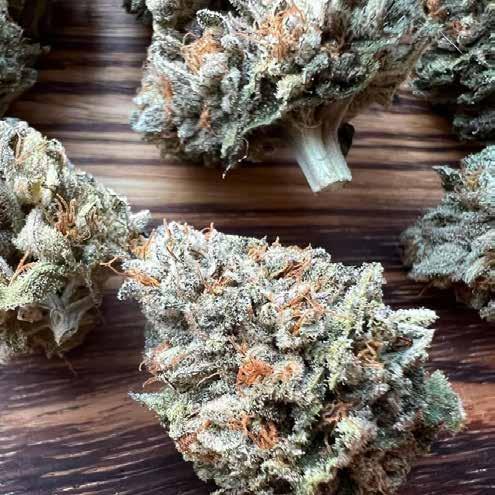

Seedbank: Dutch Passion
Strain: Sugar Bomb Punch
Pot Size: 7.5 litres
Grow Medium: Atami coco buffer substrate (50%) + Atami Worm Delight (50%)
Lighting: 2 x SANlight Gen 2
Veg Time (18/6 Cycle): 4 weeks
Vegetative Temperature: 24°
Vegetative Humidity: 76%
Flowering Time (12/12 Cycle): 8.5 weeks
Flowering Temperature: 23.5°C
Flowering Humidity: 43.5%
Sugar Bomb Punch, a feminized strain by Dutch Passion, is an indica-dominant hybrid that stems from the powerful combination of Bubba Island Kush and Critical Orange Punch. Known for its exotic terpene profile and high yields, this strain promises a rewarding experience for growers of all skill levels. Below is my detailed journey growing Sugar Bomb Punch indoors under controlled LED lighting conditions.
Vegetative Stage: 18/6
The grow began with a simple germination process. I soaked the seed in a cup of water

for 48 hours until the taproot emerged. The germinated seed was then transplanted into a 7.5-liter pot filled with a 50/50 mix of Atami coco buffer substrate and Atami Worm Delight. This nutrient-rich blend provided an excellent start for the seedling, offering beneficial microorganisms and slow-release nutrients.
In the initial two weeks, the plant was fed a mild nutrient solution consisting of Root-C, Growth-C, Alga-C, Cal-Mag, and ATAzyme at a concentration of 3 ml per litre. The plant showcased robust growth, characterized by broad, fat leaves typical of its indica heritage. Its compact size stood out in the grow tent, reflecting its naturally short and bushy growth pattern.
By day 28, I began low-stress training (LST) using gardening wire to gently tie down branches. This widened the plant’s structure, improving light penetration and promoting even bud develop-
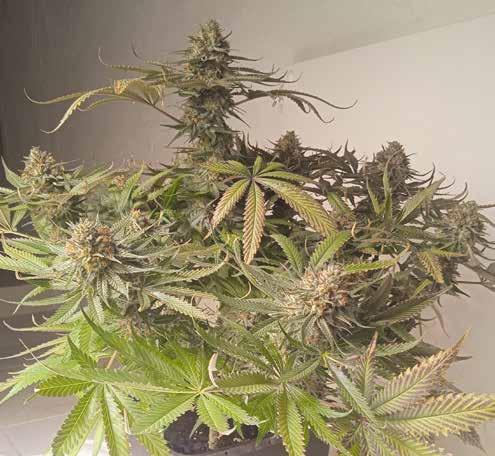
ment. Before transitioning to the flowering stage, I strategically pruned the lower growth to focus the plant’s energy on the top two internodes.
At this point, I increased the feeding concentration to 5 ml per litre of the nutrient mix. The plant measured 30 cm tall and 48 cm wide, with strong and sturdy branches that needed no additional support. To further enhance nutrient availability, I applied a top dressing of Atami Worm Delight.
Once the light cycle was switched to 12/12, the flowering phase began. I maintained a grow tent temperature of 23°C and a humidity level of 50%. Air circulation was optimized with two oscillating fans. During this stage, the plant received the same nutrient mix at 5 ml per litre. By day 21, the plant completed its stretch phase, significantly increasing its width to fill one corner of the grow tent.
By the end of week 4, I added another top dressing of Atami Worm Delight to replenish the medium. At this point, the plant measured 61 cm tall and 86.5 cm wide, with a bushy, umbrella-like structure. The dense internodes on the side branches began developing early-stage buds.


During weeks 5 and 6, the buds started filling out, taking on classic indica traits: tight, spongy, and rounded. The plant’s compact frame supported dense bud clusters along each branch. To boost resin production and promote explosive bud growth, I introduced Bloombastic (1 ml/L) three times during this phase.
The buds emitted a sweet, candy-like aroma with creamy undertones, filling the tent with a delightful scent. By day 42, the resin-coated buds sparkled under the LED lights, hinting at an impressive hash-making potential.
By day 49, the plant displayed a stunning array of colours, with fan leaves fading to pink, orange, and green. The buds developed magenta-tipped calyxes covered in tall, glistening trichomes. Feeding was scaled back to 3 ml/L, with ATAzyme increased to 15 ml/L during flushing.
On harvest day, the plant measured 64 cm tall and 87 cm wide. The buds were compact, dense, and covered in vibrant hues of green, pink, and purple. Each bud was heavily coated in resin, making it a standout in the grow tent. The terpene profile was remarkable, with notes of exotic fruit, fizzy sherbet, and sour floral funk.
The plant was hung upside down in a drying tent to preserve its resinous trichomes. The sugar-coated leaves were collected and frozen, ready for bubble hash production.
This indica-dominant hybrid delivers a deep, relaxing high, making it perfect for unwinding after a long day. Its sedative effects are strong enough to lull you into a restful nap, followed by a case of the munchies.
Growing Sugar Bomb Punch was a fulfilling experience. With its vibrant colours, resin-heavy buds, and unique terpene profile, it’s a standout strain for any indoor grower. Whether you’re seeking top-shelf buds or hash-making material, Sugar Bomb Punch delivers on all fronts, making it an excellent choice for growers of all levels.

By William Texier, founder of Terra Aquatica
What is hydroponics? In a nutshell, it is a way of growing plants in an inert substrate such as coconut fiber, rock wool, or simply bare roots. Food is provided to the plants by a nutrient solution, none comes from the substrate; one completely controls the plant nutritional diet. For this technique to give its maximum potential, it is necessary to use dynamic systems, operating in a closed circuit for maximum water savings. Hydroponic techniques provide maximum oxygenation to the roots and therefore accelerates plant growth.
One of the many advantages of hydroponics is that plants grow very fast; but this advantage can sometimes become a disadvantage. If you grow from seed indoor, under a lamp, the
plant will be far too big by the time it reaches flowering age. It will have invaded the entire vertical space; this is even truer in grow tents, which don’t offer the same height as a room. Artificial light loses much of its effectiveness with distance, so it’s a good idea to keep the lamp as close to the plants as possible, hence the interest in small specimens. For indoor cultivation large plants are more of a handicap, as any plant parts not directly exposed to light will yield a worthless crop in terms of both quantity and quality. To reap the full benefits of hydroponics, you need to adapt your cultivation to this situation: when you start your growing operation by germinating a seed, the plant that emerges from it is not destined to produce flowers.
Step-by-step hydroponics
Let’s take, as an example, a 1m2 flowering area (a single lamp). We’ll start with a seed, choosing a variety suited to indoor cultivation, i.e. one that won’t grow too tall nor flower

over a very long period, preferably a hybrid with a rather indica genetic base, so that the plant remains relatively small and stocky, and the flowering cycle doesn’t exceed 6 weeks at most. Today, there are many delicious indica-sativa hybrids well suited to this type of cultivation. The seed is placed in a substrate that allows the roots to be easily washed away. This can be coconut fiber, perlite, very light potting soil, or just plain water.
When the seedling has about two sets of true leaves, carefully dig it up, taking care not to
without substrate, or with a substrate that’s easy to clean. Perlite or coco fiber work well for rooting. Personally, I use the Terra Aquatica hydro cloner, a vortex system that has no equal in terms of success rate and rooting times. We will be flowering small plants, so we need a large number per M2. Depending on the growing system and personal preference, one can use 20 to 30 seedlings per M2
My flowering system is a Terra Aquatica GrowStream20 perfectly adapted for a 1.2X1.2 tent. I need 20 healthy cuttings, but I prefer to root many more, at least double, and choose

damage the roots. You can use a spoon to do this and scoop out the plant with a little substrate rather than pulling on it. Carefully rinse the roots in a glass of water, then place the plant in the hydroponic system. I like to use a CultiMate system at this stage, which offers good volume for the roots and protection from the clay pebbles against temperature variations. I place it under a weak Turbo neon lamp with a 18h light cycle. This plant will grow but will never flower; it’s a “mother plant”, that is a source for cuttings, which will produce the flowers. When the mother plant reaches 80cm -1 M, I attach small neon lights to the tent frame to illuminate the lower parts which are not in direct contact with the light. It wouldn’t do much good to put a more powerful lamp above the plant, it would only increase the difference in quality between top and bottom. If the plant is in a 1.2X1.2 tent, it will quickly take up all the space. Now’s the time to make clones.
Cloning
The cuttings will be transplanted into a hydroponic system, so it’s best to root them
the best ones. The key word for successfully growing this way is uniformity. You need to have seedlings that are similar in size and root quality. Choose plants that have root starts all around the stem, that have a bushy root mass and lateral hairs on the roots. With a little experience, you can easily recognize the best clones. This cutting stage will last about fifteen days in good conditions, sometimes more. It is important to keep high humidity around the clones. If your seedlings are rooted in a hydroponic system, you will be surprised to see them grow before they even have roots. During this whole process, your plants will develop and at the end of rooting, they will no longer look like they did at the beginning. This is another advantage of hydroponics, at no time is there a moment wasted.
We will now transplant our rooted cuttings into the flowering area, under a 600-w lamp or higher. Special feature: you start directly with 12 hours of light, there is no vegetative stage strictly speaking in this type of cultivation. Once again, plants grow very quickly in

hydroponics, and having a vegetative cycle would be making the same mistake as trying to flower a plant from seeds; you would get plants that are much too tall, which would go for the lamps, and with such a high number of plants per m2, you would get an unmanageable jungle, a tangle of branches, hotbed for pathogens or insects.
When you put the plants in the flowering area, they seem very small and certainly do not fill all the growing space, but there is a period in the life cycle of cannabis called pre-flowering of about fifteen days during which the plants
will grow and modify their structure to accommodate the future inflorescences. By the end of this period, they will occupy all the space reaching a size of about 40 - 50 cm. The length of the pre-flowering cycle and the final size can vary depending on the plant varieties. During this cycle, one must continue to feed the plant with a vegetative solution, at least for the first 10 days, then it is the eye and experience of the grower that will judge the right moment to change the solution. In all cases, when the first pistils appear it is imperative to switch to a flowering solution. To do this, empty the system and prepare a new solution. To make

this process easier, you can let the level drop in the reservoir during the last week of pre-flowering (do not top up) so that you only have to manage a minimum volume of solution.
After about 15 days, the plants show clear signs of flowering, with the appearance of the first pistils. By then, the young plants fill the entire growing space. From this moment, the plants still grow a little but in much less proportions than during the first phase. It is time to give them some air; with such a plant concentration, good ventilation is necessary. Cut all the branches that are not directly exposed to light, basically all the low branches. Here again, use your judgment, some lower branches rise quickly and have good potential. After that, not much to do for several weeks, just check the parameters (pH, EC, temperature, humidity) and make sure that no mold comes to wilt the flowers.
This is the growing method I use and recommend for hydroponics. You won’t get the most grams per watt with this technique, but the fact that there is no vegetative stage makes the cycle very short. What’s more, the phenomenal acceleration of growth and ripening provided by a truly active hydroponic system shortens the process still further. I save around 2 weeks on the flowering time indicated on the seed packet. I achieve a cycle in less than two months, from 6 to 7 weeks depending on the variety, with the possibility of 5 harvests a year (and a month’s vacation). This technique was developed for commercial
production, it brings a very high yield in M2/ year. With a minimum yield per harvest of 500g/M2, easily achievable, one produces a minimum of 2.5 Kg per M2 per year.
Ideally, the space should be divided into three parts. One for the mother plant, one for the cutting and one, by far the largest, for flowering. A mother plant giving enough cuttings for 2 to 3 m2 of flowering, occupies less than 1m2
Personally, I have no space for cuttings. I don’t keep the mother plant, but rather I select the best clone to be the new mother plant for the next generation. This saves space and electricity, and the new clone will be the perfect size when it’s time to take cuttings again. Each cutting is the same age as its mother. When cloning, you don’t reset the clock to zero; the plant ages, each generation is older than the last one, and you can observe the aging process, mainly through the roots, which gradually change until they become the large, gnarled roots of an older plant.
I encourage you to try this growing method for yourself. Even if you don’t want to go for five annual harvests, which takes time and work, the “cutting technique” is still interesting for one or two consecutive harvests. There’s something called “clone vigor”; it’s strange, but a cutting is more vigorous than the plant from which it comes, an added advantage. Growing indoors is expensive, especially nowadays with the high price of electricity; anything that makes the process faster results in big savings of money.
Words & Pics: Green Born Identity – G.B.I.
Anything in the Barney’s Farm range of seeds carrying “Lemon” in its name and test-grown by The Doc so far, has greatly enthralled him - Lemon Tree, Amnesia Lemon and Strawberry Lemonade. When another lemony Barney’s strain appeared on the scene recently called “Lemon Drizzle”, he was promptly fired up for it and, bingo, in a jiffy a pack of three seeds was ordered. Just too exciting and enticing was the strain’s genetic background: No less than famous elite parents
Super Lemon Haze and OG Kush gave birth to it, two true legends in the world of cannabis varieties. The amalgamation of which led to a mega hybrid distinctly leaning towards the sativa side, by 85%. Which finds expression in an accordingly energising and exhilarating turn that thanks to a high THC content of 20-25% is very intense and long-lasting. Likewise intense is Lemond Drizzle’s aroma to which both parents have contributed their trade-mark flavours: Super Lemon Haze’s characteristic sweet ‘n sour citrus core meets OG Kushs prominent piney earthiness which according to Barney’s sparks off a real flavour explosion. With its generous yield potential of up to 550g/m², the strain rewards cultivators not only qualitatively but also quantitatively. Even with a fairly short waiting time as flowering merely takes 60-65 days, really quick for a variety that much sativa dominant. Also height-wise, Lemon Drizzle has a moderate nature, with the plants not reaching taller than 1-1.2 metres.
Vigorous branching in the veg stage
As usual The Doc entered a duo into the grow race, and the two feminised seeds sown quickly hatched out of their holes in the ground, hardly 3.5 days had passed when the seedlings stood upright in the LED light already. The two Lemon Drizzles also hurried up with branching out, The Doc was amazed to see how early and vigorously numerous lateral branches were coming out of the axils in the three weeks veg stage. Which by the time flowering was initiated had resulted in a sturdy bushy growth pattern with heights of 25 and 27 cm. Given their heavily sativa-leaning pedigree, such a high degree of compactness surprised The Doc but he was certain the plants would show a strong stretch in the flowering stage.
A grand compelling flowering show
This was exactly the way it went in the first five weeks of flowering, with both Lemon Drizzle plants exhibiting much branching propensity until they had almost tripled in height. However, it was a strong stretch both vertically and laterally so that the plants kept their compact habit. Early tuberous flower cluster formation was a prelude to a grand compelling flowering show soon to begin… the plants opened their resin gates very early, releasing plentiful amounts of trichomes that in the course of flowering gushed over the rapidly swelling buds until even bigger five-fingered leaves were extensively coated in resin glands. Near the end, after nine weeks of flowering, The Doc reported: “That’s absolutely


smashing! These Lemon Drizzle buds are real humdingers. The utterly massive trichome frost their calyxes and leaves are covered with is sheer eye candy, I can see the buds’ silvery gleam already from a distance. Another intriguing highlight, plants are hanging resplendent with an astounding amount of 16 and 18, respectively, side tops some of which are as large-sized as the head bud! This whole scenario looks and feels like a terrific jackpot of a bud lottery, really overwhelming. The tremendously sweet and spicy flower scent is every bit as bewitching, reflecting the characteristics stated by Barney’s – there’s
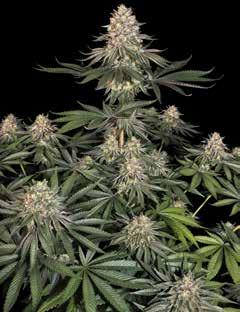
manner conveyed the three salient Lemon Drizzle flavour aspects spicy, sweet and sour to his sense of taste – “palatefulness has a name: Lemon Drizzle!”, The Doc phrased with relish. Just like the taste, the effect came over him like a rocket: Lemon Drizzle fully expressed its sativa character, right after the first puff he perceived a gently prickling sensation in his arms which after the third one felt so electric in his whole body that it was time to move - as if The Doc had received a marching order from his brain, he bounced up from the couch and swiftly headed to the supermarket nearby as he had gotten the munchies, so he bought himself a pizza plus some sweet and spicy nibbles. Which he did with a breezy cheerfulness as Lemon Drizzle had not only given him an irresistible stimulus to move, but also a strong mental positivity boost.
“This is such a lovely mood-lifting and activating
sort of marijuana!”, he raved about Barney’s Farm’s new strain creation. To not get lazy and stuck in the couch after his copious meal, he took three more vaporizer hits which kind of catapulted him to the party in his neighbourhood he had been invited to.
„Everything is turned into green gold…“
„Once again a lemony Barney’s strain has turned out to be extremely award-worthy – Barney’s Farm’s winning streak in my grow room just doesn’t end, it’s one mega strain after another. Whatever the Barney’s breeders put their gifted hands on is turned into green gold!” – for a good reason, The Doc’s enthusiasm about a Barney’s variety knew no bounds.
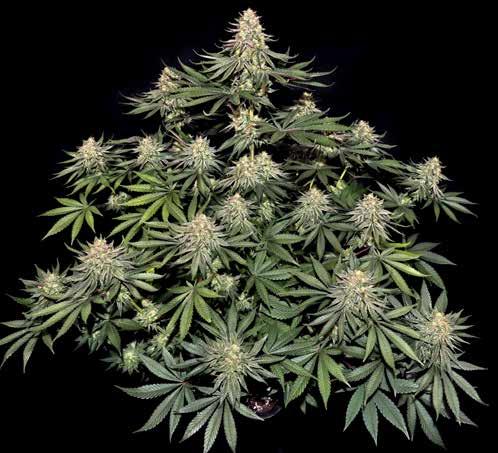
both that typical bold piney Kush spiciness and a good dash of lemon. Sweetened with a note of forest honey, it’s a rich fascinating melange strongly appealing to my sense of smell.”
It took those grandiose Lemon Drizzle buds 64 and 67 days to become well-cooked. The plants were standing 74 and 80 cm tall in the end.
A bumper yield of buds with a masterly perfected aroma
The dry yield outcome proved to be above average some weeks later, above average also for The Doc’s own standard which is on a higher level than the usual Joe Grow’s – most bountiful 122 and 131 grams his Lemon Drizzles had produced! As always through drying and curing in the jars, the buds’ aroma was even more concentrated now and masterfully perfected, with a fine interplay of the three main elements pine, lemon and honey resulting in a hefty fragrance that gave The Doc a right-in-your-face experience when he opened one of the jars to take a bud out of it for his first sampling session.
The sampling session: Firing rockets…
When this 0.5g bud went up in vapour in his Venty vaporizer then, Lemon Drizzle fired a flavour rocket in The Doc’s mouth that exploded on his palate and, perceivedly at least, coated it with an aroma film that in a most delectable and intense
Genetics Lemon Drizzle (Lemon Haze x OG
Vegetative stage 21 days (after germination)
Flowering stage 64+67 days / 60-65 days in general
Medium Bionova Bio Soilmix, 11 litre pots
pH 6,4-6,7
EC 1,2–1,6 mS
Light Veg stage: 2 x SANlight EVO 5-100, switched to level 2 out of 3
Temperature 18-29°C
Air humidity 40-60%
Watering Manually
Fertilisation Bionova Soil Supermix, plus PK 13-14 in the flowering stage
Additives/stimulants Bionova Silution, The Missing Link, Vitasol and X-cel
Tools CleanLight Pro for mould prevention
Height 74+79 cm
Yield 122+131 g

With Stoney Tark
In this article, I talk you through all the available hydroponic systems, allowing you to decide which may be best for you, based on your growing space, skill level, and growing experience. I break down the differences between soil and hydro, the most commonly used systems, and explain the pros and cons of each, allowing you to make the best possible decision.
If you have been growing for years using soil and would like to improve yields and save hand watering, then you may have thought twice
about using hydroponic systems. Hydroponics is a way of growing cannabis without using soil and can be far more efficient in the long run, saving costs on high energy bills, nutrient use, and frequent trips to the grow store.
Soil-grown cannabis plants rely on roots absorbing nutrients that are slowly released and buffered over 72 hours. Beneficial microorganisms and bacteria will break down the organic matter and make humic, fulvic, and amino acids readily available to the roots, as well as primary nutrients, secondary nutrients, and a profile of trace elements.
Hydroponics works differently by supplying liquid chemical salt-based nutrients from a reservoir and pump to the plant’s roots, as they are suspended in an inert growing medium. This means that the roots do not need to wait 72 hours to buffer, and can instantly use up the

primary, secondary, and trace minerals that the plants require during the different stages of their life cycle.
1. Dripper System
These are the most common types of hydroponic systems that are best suited for beginner-level growers and are often used for large commercial-scale operations. This type of system uses a pump, drip lines, and dripper stakes, set at 15-minute intervals.
2. Deep Water Culture
D.W.C systems work by allowing the roots to sit suspended inside a reservoir of nutrient solution, that will have an air pump producing dissolved oxygen 24 hours a day. Deep water culture systems will have high maintenance levels, but the yields will typically be the biggest out of all the hydroponic systems in this list.
3. Nutrient Film Technique
N.F.T systems are available in small sizes or large tables. The roots are in constant contact with a film of nutrient solution, and the roots can grow very large. I love using N.F.T systems as they are extremely rewarding when you dial them in and only require a small pump to recirculate the nutrient solution.
4. Flood and Drain Tables
These hydroponic systems use hydroton in pots, that become flooded with the nutrient solution, and then drained back until the table is empty. It is possible to feed plants grown on a flood and drain table between 4–6 times per day and an excellent way to replicate a Sea of Green setup using smaller-sized pots.
5. Aeroponics
This type of system works by allowing the roots to be suspended inside a chamber, which will spray them with the nutrient solution using a spray nozzle connected to a pump., and then produce air around the roots every 15 minutes. Aeroponic-grown cannabis plants will grow quickly and tend to become tall and capable of big yields.
6. Reverse Deep Water Culture
R.D.W.C systems can be complex as they combine multiple D.W.C buckets at once. There is a much higher risk of a problem arising and should be used by a grower with experience with D.W.C, and some prior knowledge of plumbing. However, they are
superb systems in the right hands and the yields can be incredible.
• Hydroponics can produce large yields compared to soil-grown crops.
Short vegetative times are required to save electricity and nutrients. There is no need to hand water, saving time and labour.
Hydroponics are well suited for small grow spaces.
• The turnaround time between harvests is much shorter.
• Systems can always be modified and customised.
• Hydroponic systems can produce superb yields in a Sea of Green setup.
• Hydroton and coco coir can be washed and reused, saving costs.
• There is no need to carry large bags of soil to and from the grow room.
• Plants will grow much faster and bigger compared to organic crops.
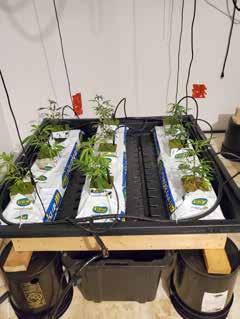
If you are totally new to hydroponics, then I would recommend starting off learning the ropes with a dripper system and working on a small scale. Those who fancy more of a challenge can try either N.F.T or flood and drain systems, and for the more experienced grower, deep water culture or reverse deep water culture will be the ideal challenge and the biggest yielding systems available.
Brings magic to plants and soil in one go and soil and soil and soil and soil and soil and

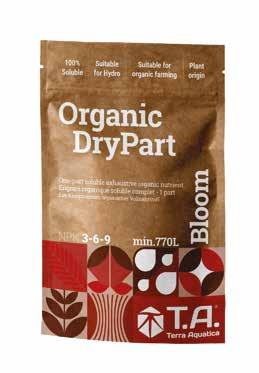


CANNABIS EXPERT VS BEGINNER IN EIGHT EPISODES
Biology
by Hortizan
Thrips, tiny insects measuring between 0.8 and 2 mm long, are much more formidable than they seem. With their yellow-brown color and narrow, hair-fringed wings, they may seem harmless. It is this specific character which gave them their name thysanoptera (from the Greek pteron, wings and thysanos, fringed);
the term “thrips” also comes from the Greek, meaning “woodlice”. Biting-sucking insects, they nevertheless participate in numerous pollinations, but they are considered harmful, due to the extensive damage they cause to plants. Their dazzling reproductive capacity, their very diverse diet, and their insatiable voracity make them formidable pests for agricultural and horticultural crops.
Thrips feed on the contents of plant cells. Their mouthparts pierce leaf tissues to suck up fluids, leaving them empty and full of air, creating silver spots (see pic.1). On fruits, their attacks are manifested by deformations and
which causes tomato spotted wilt (TSWV), and its relative, impatiens necrotic spot virus (INSV), are good examples.
The life cycle of thrips has five stages: egg, larva, prepupa, pupa and adult. At a temperature of 20°C the complete cycle takes approximately 19 days, while at 25°C it can be reduced to 13 days. Females lay eggs in plant tissues, then the larvae develop on leaves, flowers and fruits, before usually pupating in the soil, between the 3rd and 4th stadium.
Among the many species of thrips, certain species are particularly harmful to our crops: The most widespread species, Frankliniella occidentalis (small fruit thrips) (see pic.2), is native to North America. Now present worldwide, it invades various crops, including cannabis, vegetables and ornamental plants. The Thrips tabaci (onion thrips), widespread worldwide, varies its life and reproduction cycle depending on the temperature. It attacks many crops such as onions, tobacco, tomatoes and peppers. It also spreads viruses like tobacco mosaic virus (Tobamovirus). Finally, Frankliniella tritici (flower thrips), although less known, feeds on pollen and petals. It causes discoloration and scarring of flowers, affecting some ornamental and vegetable crops.
There are multiple solutions to combat thrips. A good integrated pest management (IPM) approach provides a sustainable strategy for

discolorations. In addition, small dark spots appear, corresponding to their droppings. These pests affect many vegetable crops: cucumber, tomato, pepper, eggplant, etc. In horticultural crops, thrips cause damage to roses, cannabis (obviously), as well as chrysanthemums, gerberas, etc., leading to scarring and deformation of flowers. Problematically, thrips are important vectors of pathologies and can transmit many viruses from one plant to another. Tospovirus,
managing thrips populations. This approach combines several control methods, ensuring effective management while minimizing environmental impacts. Early monitoring and detection is crucial to spot thrips before they cause significant damage. The use of sticky traps, strategically placed in crops, are particularly effective in monitoring population developments. Regularly cleaning greenhouses and installing screens over openings can reduce
thrips infestations and keep these insects out. It is also necessary to think about crop rotation and the elimination of host plants that could serve as shelter. Another advantage is biologi-

cal control: it promotes a natural balance and limits the use of pesticides. Against thrips, it is recommended the introduction of natural predators such as lacewing larvae (Chrysoper-
la carnea), predatory mites (Amblyseius swirskii or cucumeris), the predatory bug Orius insidiosus, or even nematodes (Steinernema feltiae). The use of pesticides (biological or chemical) may be necessary in certain extreme cases. Application should be targeted and used as a last resort to minimize impact on the environment and non-target organisms.
In conclusion, thrips pose a serious threat to many crops due to their rapid reproduction ability and destructive feeding method. However, proactive and integrated management can minimize their impact. By combining regular monitoring, cultural measures, biological and chemical control, it is possible to effectively control these pests. Continued research into the ecological interactions of thrips will open new avenues for even more effective and sustainable management. By integrating cutting-edge solutions such as smart sensors and next-generation biopesticides, growers will be able to anticipate and respond to thrips threats even more precisely and environmentally friendly.



Text: Derrick Bergman / Gonzo Media
“Some of his work is probably in the cannabis you smoke today”

David Watson, aka Sam the Skunkman, has done more for cannabis than Bill Gates did for computers. The most secretive of all cannabis pioneers was already a myth during his lifetime. He died on January 27, 2025 in California, aged 75.
The Netherlands is Watson’s second homeland. In 1984, he fled the US and moved to Amsterdam, with tens of thousands of cannabis seeds in his luggage. A true genetic treasure, which he has amassed in the years before. Sacred Seeds is the name of its seed bank, the first in the world. He received seeds of the original Haze from the Haze Brothers, but it is his own Skunk #1 that will change everything.
Weed was grown in the Netherlands before Watson came here with his seeds, but the
quality was deplorable. No one is concerned with species crossing or stabilization; hobby growers use random seeds from imported cannabis from Jamaica, Thailand and other distant regions. The care and thoroughness with which Watson works to preserve species and develop new crosses is unprecedented.
With his wife Diane he travels along the ‘Hippie Trail’ through traditional hashish countries such as Afghanistan, Pakistan and India. He collects seeds everywhere that he grows and selects at home in California. An old Sacred Seeds package reports on that process:
‘100% organically produced from imported seeds, carefully grown in isolation to guarantee absolute varietal purity. These seeds are collected only from fully mature female plants, carefully
selected for extra large, resin-covered flowers and exceptionally early, vigorous, healthy, disease and pest resistant, high yielding plants (grown only once in the San Francisco Bay area to selection and acclimatization and create these seeds).’
For his legendary Skunk #1, Watson crosses Colombian Gold with an Afghani strain. He crosses the result with a Mexican classic, Acapulco Gold. The resulting hybrid spreads such a pungent odor that it is given the name of the skunk: Skunk.
Once in the Netherlands, Watson quickly comes into contact with kindred spirits such as Wernard Bruining (Positronics and Sinsemilla Fan Club), Nevil Schoenmakers (The Seed Bank of Holland) and Karel Schelfhout (Super Sativa Seed Club). They help spread Watson’s strains and use his genetics for new crosses. He does this himself with the successor to Sacred Seeds, Cultivators Choice.
Robert C. Clarke, who was friends with Watson for half a century, writes in his obituary: ‘His steady supply revolutionized global home cultivation, laid the foundation for today’s most popular sinsemilla varieties and spawned the steadily developing international cannabis industry continues.’
In the 1990s, Watson founded Hortapharm BV, one of the first medicinal cannabis companies in modern history. The company had a permit from the Dutch Ministry of Health, Welfare and Sport for a number of years to conduct scientific research into cannabis. Hortapharm later collaborated with the British GW Pharmaceuticals, which uses Skunk #1, among other
things, for its cannabis medicines.
Watson never allowed himself to be photographed; he was the man without a face. When I spoke to him in Amsterdam on December 7 last year, he explained why. “I had two personas; I was Sam the Skunkman and David Watson from Hortapharm. They had to remain separate.”
Still living in Amsterdam, he flew to California with Diane at the end of January ‘25 ans sadly died there soon after due to natural causes.
Rest in Peace Sam, you were a true legend!


Yakandi
yakandi.medicinal@gmail.com
We were looking for a variety that had high production and resistance to high temperatures, which are occurring in summer due to climate change. On this occasion, we grew two photoperiod-dependent feminized Sweet Zenzation specimens in two different greenhouses. The differences in the greenhouse conditions produced plants with notable differences.
Sweet Zenzation specimens were germinated in mid-April. They had a growth period of about two months, before being transplanted in June into large pots of about 400 L. During the growth period they were accompanied at night by a light of only 9v, which simply kept them awake and growing.
One specimen was transplanted into a greenhouse, where it had little exposure to wind and a little less direct light during the first half of the day. The other specimen was grown in another greenhouse, in a spot where it received more wind and unfortunately also mites and dust, but also direct sunlight throughout the day. This difference in growing conditions produced noticeably different results for the two plants.
As for nutrients, we used Root Juice from Bio Bizz and Rhino Skin from Advanced Nutrients during the growth phase. We then used molasses, sea water and coconut water for the flowering phase, with a support of Brutal Buds at 0.6g – 0.8g per litre every two weeks. The temperature was stable during the
growth stage (less than 30ºC), but reached very high maximums during the summer heat waves, reaching 40ºC on several occasions. This generated considerable stress in several plants that produced some seeds and were stunned as soon as the buds fattened.
The plant that grew in more protected conditions had little trouble growing into a dense bush and starting to flower in late June. Even though it suffered some stress from the heat waves, it was able to complete its cycle showing greater resilience than the other plants. The specimen we grew in the other


greenhouse faced greater challenges, but it also grew strong and productive.
The increase in temperature and humidity imbalances caused some of the other plants in that greenhouse to suffer from root fungus. Sweet Zenzation did not suffer from this.
With the increase in drought we saw an extreme increase in haze and winds, which bring this contamination in the direction of the second greenhouse. Because of this, we had a mite attack that we had to fight fiercely for several weeks to save the plants in that greenhouse. We used potassium soap with neem oil and Spider Mite Control.
The Sweet Zenzation that was on that battlefield, despite its flowering being slightly delayed compared to the other specimen due to mites and environmental stress, showed incredible resistance to all pathogens. While other plants were weakened, it continued to grow and grow, reaching over two meters in height in July.
The plant in the most protected greenhouse finished flowering at the end of August. The buds were quite dense and very resinous. The internodal spacing was tight, with strong and thick branches. Its abundant and resistant leaves turned multi-coloured towards the end of flowering and was a very pretty sight. Its height was 1.50 metres and it produced a total of 160g dry, approximately 225g wet.
The specimen exposed to greater challenges in the other greenhouse took longer to start flowering, throughout July, while it continued to grow to over 2 metres tall, almost touching the greenhouse mesh which is 2.20 metres away. Due to this stretching, the internodal distance was greater than in other plants. And since it was so far behind the others, added to the stress of wind and heat, I did not have much hope for it.
However, it resisted pathogens, such as mites and root fungi, better than its other greenhouse companions. Its trunk grew thick and firm, practically a wind-resistant tree. After having already cut the other plants, in mid-September, its branches, although loaded with buds, seemed not to gain much more weight.
We continued waiting for a couple of weeks

and when, after observing the trichomes, we decided to cut it, we got a big surprise. Despite the apparent separation between the buds, due to the size of the plant and the large amount of resin, it gave us a harvest of 413g dry, more than 550g wet. It was the
largest amount per plant that year, and for several years, the queen of the greenhouse.
Powerful and aromatic effect
The effect of Sweet Zenzation starts the mo -
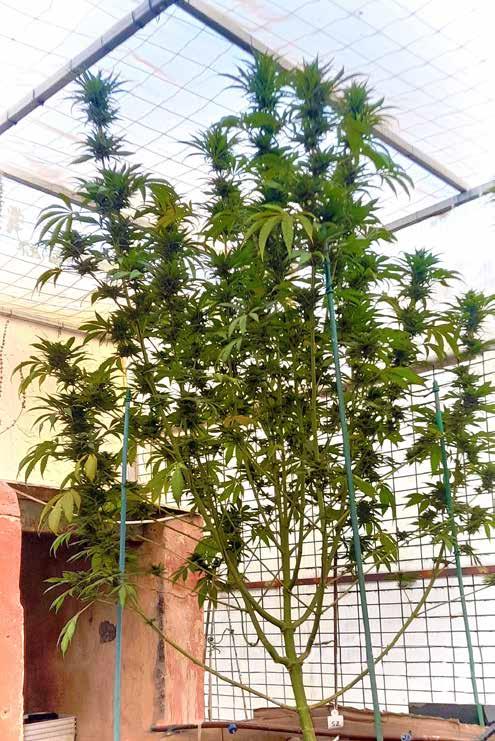

very
ment you smell it, as the sweet and slightly citrusy aroma of its terpenes floods your senses and transports you to another place even before you taste it. This is probably due to the fruity sweetness of its genetic mother Zkittlez. When vaporized or smoked, the effect is indica in nature, as its genetics are 70% indica. It produces bodily sensations of relaxation and helps relieve muscle tension and pain. At the same time, it is potent on a psychoactive level and generates a pleasant mental stimulation.
This variety is highly recommended if you are looking for a resistant plant, capable of reaching large dimensions and with a high production of flowers in due time. It is ideal if you live in a place with long summers and are not in a hurry, so that the plant can take its time and give you a world-class harvest. If you are in a hurry, you can induce flowering earlier and control its size, obtaining equally great results.


Text: Ed Rosenthal
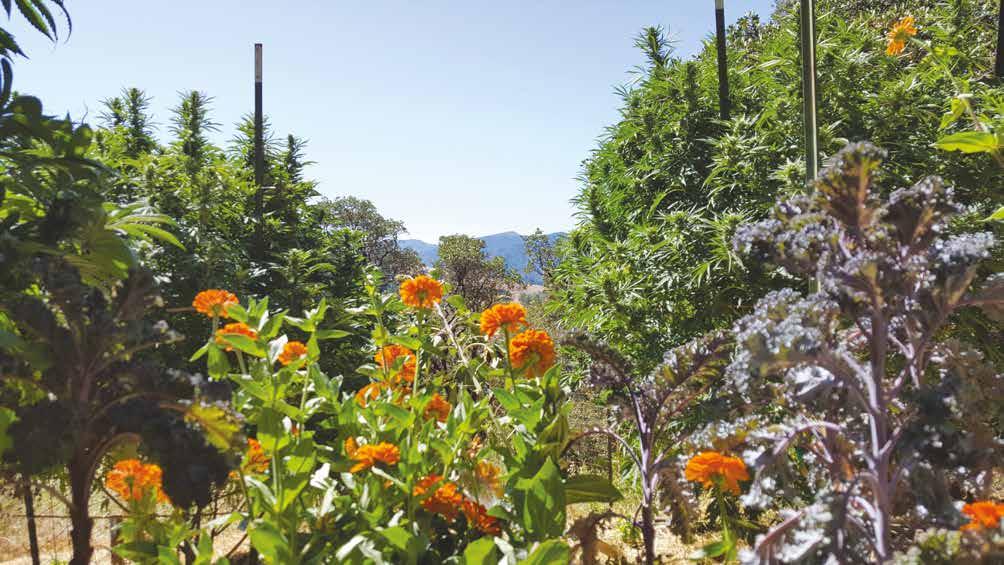
Geographical Indications (GI) and Designations of Origin (DO) are internationally recognized intellectual property systems, offering important opportunities to protect valuable traditions and genetic resources for people around the world. A Geographical Indication is a sign used on products that have a specific geographical origin and possess qualities or a reputation that are due to that origin. Appellations of origin are a special type, or subset, of a geographical indication, in the sense that the qualitative links between the product and the place must be stronger than those of Gis.
In the case of a designation of origin, the quality or distinctive characteristics of the product must be derived essentially or exclusively from its geographical origin. “Terroir”, a French term, is commonly used to describe the combination of factors such as soil, climate and sunlight that give a product its distinctive character. These standards-based regulatory systems act to codify traditional knowledge and traditional agricultural practices, as well as to protect valuable genetic resources, resulting in the harmonization of respective intellectual property standards, values and technologies between participating countries. in the trade of products with DO.
How could these systems be applied to marijuana?
Recognized by farmers as a highly adaptable plant, Cannabis is greatly influenced by the environment in which it is grown. As marijuana seeds spread throughout the world, the plant was cultivated for different uses and adapted to a multitude of natural environments, leading to the development of countless cultivars with distinctive variations.
There are many regions known for unique cultivars that produce high-quality inflorescences with distinctive characteristics, attributed in part to the original environment in which it was grown and bred. This includes geographic regions known for modern marijuana breeding, such as California’s Emerald Triangle and regions of Spain, but especially the numerous regions of central and southeast Asia where the plant evolved. This includes countries such as Afghanistan, Bhutan, India, Nepal, Thailand and Vietnam, as well as many areas of Central and South America and the Caribbean.
Despite decades of international marijuana prohibition, the best-known of these regions established global brand recognition among
patients, consumers and the public. As regional recognition increased, so did the demand for Cannabis products from these regions. However, as regional fame grew and product value increased, so did the number of branded products with regional names grown or manufactured outside the named region.
Development of the first global GI and DO programs for marijuana
In 2015, nearly 20 years after the passage of the Compassionate Use Act, the California Legislature established the Medical Cannabis Regulation and Safety Act (MCRSA). The MCRSA created a state framework to regulate medical marijuana and established two very important geographical indication programs for Cannabis: County of Origin and Appellation of Origin. In 2019, subsequent legislation was passed that reinforced the appellation of origin status.
In 2020, the California Legislature passed Senate Bill 67, which expanded the County of Origin program to also include indications of origin from cities and counties based on political boundaries. Allows marijuana and cannabis products, 100% made within the boundaries, to be named after the county, city, or city and county.
Additionally, and perhaps even more importantly, Senate Bill 67 established terroir-based ground rules for the California Appeal Program (CAP), which requires that in order for marijuana to be eligible for an appellation of origin seal , should be grown in the ground, without the use of a structure and without the use of artificial or supplementary lighting in the flowering phase.
Way to establish a Designation of Origin of Cannabis in California
To establish an appellation, a group of licensed growers located in the proposed appellation region must prepare and submit a petition to the California Department of Food and Agriculture for review and approval. Consistent with appellations of origin for products such as wine, champagne and cheese, the California Cannabis Appellation of Origin program requires the applicant to, among other things, do the following:
1) Show evidence of historical use of the name
2) Describe each of the geographical characteristics that affect the Cannabis produced in the geographical area of the proposed designation of origin, including: Climate information, which may include
“THESE STANDARDS-BASED REGULATORY SYSTEMS ACT TO CODIFY TRADITIONAL KNOWLEDGE AND TRADITIONAL AGRICULTURAL PRACTICES.”
temperature, precipitation, wind, fog, solar orientation, and radiation
Geological information, which may include underlying formations, landforms, and geophysical phenomena such as earthquakes, eruptions, and major floods
Soil characteristics, which may include microbiology and soil series or phases of a soil series Physical characteristics, which may include flat, hilly or mountainous topography, geographic formations, bodies of water, watersheds and irrigation resources.
Cultural characteristics, which may include political boundaries associated with a history or reputation, the distribution of a specific set of cultivation practices, and anthropogenic characteristics
Minimum and maximum elevations.
1. Provide substantial evidence that the geographic area is distinctive, when compared to areas outside the proposed limits and to other relevant areas that produce marijuana for sale in the market
2. Provide an explanation of how the geo-
graphic feature is considered intrinsic to the identity or character of the area by means other than those required by state law, regulation or ordinance
3. Provide a description of the quality, characteristic, or reputation of the Cannabis caused essentially or exclusively by the landform, including an explanation of how the landform causes marijuana to have that quality, characteristic, or reputation
4. Identify at least one specific cultivation rule, practice or requirement that acts to preserve the distinctive character of the geographical feature, maintaining its relevance to marijuana produced in the region of the appellation.
5. Planning and establishment of a cultivation site with designation of origin
Marijuana must be planted in the ground. Planting Cannabis in the soil ensures that it is produced in the appellation region, influenced by the indigenous soil and microbiology of each appellation region. Various methods can be used to plant in the ground, such as tilling or turning native soil, mulching with leaves, and terracing

with mounds. The type of soil amendments or additives permitted, as well as the permitted method or methods of planting in the soil, must be in accordance with the relevant standards and/or practices established by the designation.
Marijuana must be grown without using any structure.
Cannabis produced in the designation of origin area must be grown outdoors, without using greenhouses, hoop houses, shade houses or other structures that may alter the natural temporary environment of the designation of origin area. The use of light deprivation techniques is also prohibited, as this technique not only manipulates the temporal environment in which marijuana is produced, but also alters the hours of natural sunlight that the plant would otherwise receive.
Producing Cannabis without the use of a structure also prohibits the use of covers temporarily to protect from natural conditions such as early frost, rain, and/or smoke particles from nearby wildfires.
Marijuana should be grown without using artificial or supplemental lighting.
Although artificial or supplemental lighting may be used to support the growth of mother plants and for other propagation activities, artificial or supplemental lighting will not be used once the plants are greater than 18 inches (46 cm) in height or width. This basic rule guarantees that marijuana is grown using natural sunlight, subjecting it to the natural light hours of the appellation region and the intensity of sunlight.
Irrigation water and water sources
In addition to the basic terroir-based standards established for the California Cannabis Appeals Program, water used to irrigate marijuana must come from the region of the appellation and in its original “untreated” form. Such water sources could include permitted surface water, such as streams, creeks, rivers and springs, or groundwater from a well or aquifer, as well as rainwater captured and stored within the naming region.
In some DO regions, natural environmental conditions completely eliminate the need for irrigation, allowing farmers to use rainfed farming techniques. Rich floodplains, such as the Holmes Flat area in the Eel River Valley of Northern California, where historical flood cycles have deposited layers of silt and forest litter on the valley floor, and the water table is naturally tall, they are perfect for dryland agriculture of a multitude of agricultural crops, including Cannabis.
The benefits of GI and DO programs for consumers
Both geographical indication and designation of origin programs offer consumers the opportunity to verify the origin of the products they purchase, as well as directly support the economy of the original community. Designated origin products offer consumers additional opportunities, such as the ability to verify product production standards, as well as the unique ability to experience the taste of a place and the subtle differences between a cultivar produced in different regions of the world. denomination.


Grow with Mr. José
Mr. José, info@pestovat.cz
The Hop Latent Viroid (HLVd) can be aptly compared to the COVID-19 of cannabis plants. While it poses the greatest threat to commercial growers, its spread to home grows should not be overlooked. Where did HLVd come from, what does it do, how can it be identified, and what steps can you take to protect your grow and plants? Find out in the following article.
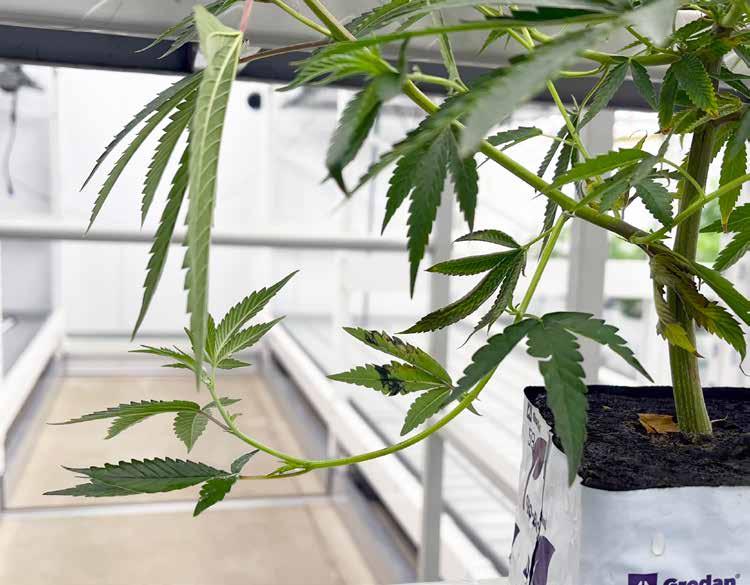
Discovery of HLVd and Transmission to Cannabis
HLVd was first identified in 1987 in commercial hop varieties in Spain. Until recently, it was known solely as a pathogen of hops and related plants, such as Japanese hops. However, in 2019, HLVd was detected in cannabis for the first time in California, where it caused what is now referred to as “dudding disease.” This term describes the primary visible symptoms of HLVd infection, including stunted growth and other morphological changes, which we will discuss further.
The viroid was initially detected in an indoor cannabis grow. The question remains: how did it get there, given that HLVd was previously only known to infect hops? HLVd can spread through mechanical means or via seeds and clones. Its transmission through air or insects has not yet been confirmed. Contamination might have occurred through gardening tools or clothing that had previously been used in contact with infected hops. Another possibility is that transmission occurred during outdoor
cultivation, with the viroid being introduced into indoor facilities through clones or seeds obtained from infected outdoor plants.
High concentrations of HLVd have been detected in the roots of plants, where it can be identified shortly after infection. This

raises the possibility that the viroid was introduced into indoor facilities via contaminated growing substrates or composted materials. It is also known to spread through irrigation systems, particularly recirculating ones. While this might not have been the initial route of infection, it undoubtedly plays a significant role in the viroid’s rapid spread within facilities.
The spread of the viroid among growers and its dissemination from the U.S. to virtually every cannabis-growing country can be attributed to the distribution of infected clones and seeds among both commercial and home growers. Clones from the U.S. were purchased by large-scale producers in Canada, Europe, and Asia. Considering the immense popularity of Californian strains and the fact that the viroid’s presence went undetected for some time, it becomes clear why this disease has become so widespread.
Symptoms of HLVd in Cannabis HLVd is a viroid, meaning it is incredibly small. To illustrate its size: if a bacterium were the size of a watermelon, a virus would be roughly the size of a grape, and a viroid would compare to a poppy seed. HLVd can remain latent for an extended period, showing no visible symptoms. This means you could have it in your grow room or garden without noticing anything unusual. However, once it becomes active, it causes the characteristic stunted growth. Leaves become smaller, plants grow slowly, and internodal spacing is significantly reduced. These symptoms could also be attributed to poor nutrition or suboptimal environmental conditions, making accurate diagnosis essential.
A particularly noticeable symptom is stem brittleness. Plants do not grow very tall, and both the main and lateral branches bend, appearing unable to support their own weight. Lateral branches tend to grow horizontally and easily break off from the main stem. Another possible indicator is the yellowing of leaf veins. However, this symptom is not exclusive to HLVd and is often caused by other issues, so it’s important not to jump to conclusions solely based on this observation.
The most critical issue caused by the active form of HLVd is its impact on trichome production, leading to a reduction in secondary metabolites like cannabinoids and terpenes. When all symptoms are combined, infected plants are smaller, weaker, produce smaller flowers, and generate less resin. Cannabinoid production can drop by as much as 30–50%, which is a significant loss. This decline occurs because HLVd disrupts genetic and metabolic processes in the plant, resulting in lower activity of enzymes responsible for cannabinoid biosynthesis.
If you are uncertain whether your plants are infected and want to confirm it, you can have them tested. Typically, a small root sample
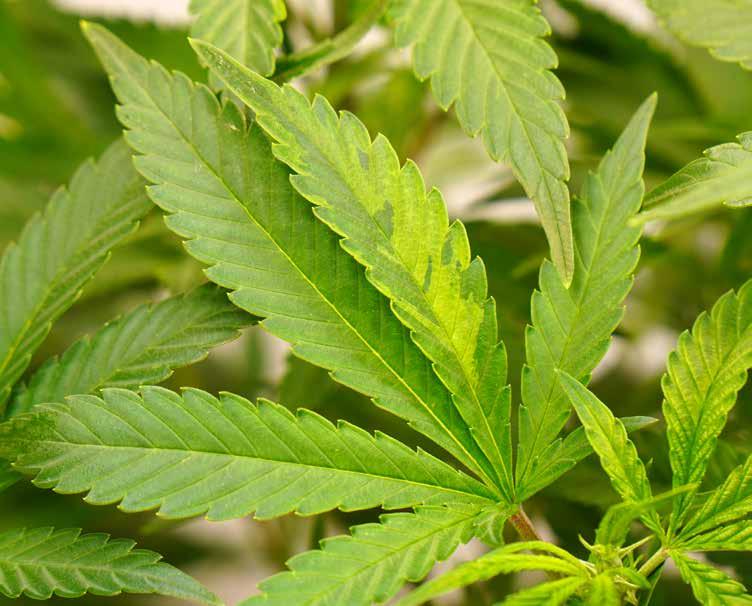
is sufficient, and labs specializing in HLVd detection can perform the test. The cost is relatively low, usually under 1,000 CZK per sample. If you have mother plants and propagate clones from them, investing in testing is highly recommended.
Prevention and Protection
As mentioned earlier, HLVd is extremely small and highly resilient. Once it finds its way into your grow room, it will be challenging to eliminate. Therefore, prevention is key. A fundamental rule is to never introduce plant material into your grow space that has not been tested for HLVd. Many seed vendors now offer batches that have been screened for this infection. The same applies when growing from clones. If you plan to use clones from someone else to establish your own mother plants, always have them tested for HLVd and keep them in quarantine, separate from your other plants, until the results confirm they are infection-free.
In commercial operations, it is essential to perform regular and repeated testing while implementing strict hygiene standards and procedures. This minimizes the risk of pathogen introduction and ensures early detection in case of infection.
The most critical step is the regular sterilization of tools, pots, pruning shears, and all components of irrigation systems. Alcohol alone is not reliable for eliminating the viroid. An effective solution is **NaClO (sodium hypochlorite)**, found in products like the Czech brand Savo. UV-C light sterilization is also highly effective, but it must be carried out in the absence of people, animals, or plants. Common sterilization methods, such as autoclaving, boiling water, or hot steam
for at least 10 minutes, are also effective.
Monitor the health and morphology of your plants closely. If you suspect that your plants are infected with the active form of HLVd, perform a test on at least one plant. If the presence of HLVd is confirmed, the best course of action is to dispose of all plants and thoroughly sterilize the entire grow space and all tools. This process requires effort, and the outcome will depend entirely on how diligently the sterilization is carried out.
HLVd in its latent form does not affect the growth or production of plants. This means you could have it in your grow room for years without noticing any symptoms. This might also be because you are growing strains that are more tolerant to the disease. This phenomenon is common with hops, the original host of HLVd. However, due to the high value of cannabis, HLVd is a much bigger problem for cannabis growers than for hop farmers. In hops, the viroid can cause reduced bitterness or lower yields, but the financial losses are not as significant as those faced by commercial cannabis growers.
In my experience, I have encountered both latent and active forms of HLVd. The most severe active infection I observed was in an experimental trial with the low-potency strain *Eletta Campana*. Unfortunately, I couldn’t find archived photos that clearly depicted the morphological issues. Another highly infected strain was a CBD variety, where the most noticeable symptom was a significant reduction in resin production. On the other hand, I observed a long-term latent HLVd infection in the *Euforia* strain by Dutch Passion. Even after prolonged exposure to an environment
with infected plants, tests revealed only a minimal infection in this strain.
HLVd is here to stay in the cannabis world, and we can expect that strains showing higher resistance to this pathogen will become more prominent in breeders’ grow rooms. In the near future, we might see strains that are less affected by HLVd, making the viroid less of a problem for growers.
Can HLVd Be Eliminated?
Once introduced, HLVd is extremely difficult to eradicate from a grow space. Sterilization and preventive measures can help prevent its spread, but there is no way to cure the viroid in an infected plant. The only effective method is **meristem tissue culture**, a process that involves isolating and cultivating the plant’s apical meristems in a laboratory setting. The apical meristems are less likely to contain the viroid, and the process is often supplemented with a form of chemical therapy to remove any residual traces of HLVd.
This procedure is expensive and time-consuming, and it is only worthwhile in exceptional cases where a grower needs to preserve an irreplaceable strain.
I wish your plants stay healthy, and may your cultivation endeavors be successful!




Jorge Cervantes jorge@marijuanagrowing.com
Mutant cannabis plants are fun to grow and interesting to look at, but do not expect a high yield of potent compact flowers. Mutant plants are more common today because so many people are making unstable genetic crosses. For example, in 2021, three mutant varieties are growing in my friend´s 20-plant garden. He purchased all the seeds on the commercial market. Another breeder friend in Oregon is growing 60,000 plants and finally found two mutant plants. Stable genetics breed stable plants.
A quick search for “buy mutant cannabis seeds” will net pages of companies offering “mutant” seeds. The term “mutant” is used by some seed companies as a catch-all word that describes the variety they offer. Most mutant plants make very poor breeding specimens and should be discarded. But a few companies such as, https://kalyseeds. eu/, specialize in mutant varieties. Many seed companies offer relatively stable Australian Bastard, Ducksfoot and Freakshow cultivars. Oregon CBD Seeds is considering releasing an ornamental fasciated variety too.
Cultivation inconsistencies and stress can lead to odd growth that is not a product of genetics. For example, dynamic temperature fluctuations can cause stems to stretch. Roots can form along stems in humid environments. Both “popcorn” buds and wispy, lightweight flowers are caused by cultural stress. Revegetating a plant causes inconsistent leaf growth. See chapter six, Flowering, for more information. Changing the photoperiod from 12-hour nights and days to 6-hour nights and 18-hour days after a couple of weeks confuses cannabis plants. See chapter twenty, Light, Lamps and Electricity, for more information. Most oddball growth is caused by hormonal imbalances and stress including diseases, pests, chemical exposure and temperature extremes. Mutations are a function of genetics. A small percentage of plants with genetic mutations are beneficial, but very difficult to incorporate into a breeding program. Most often, mutants and oddballs are best discarded and destroyed.
According to Seth Crawford, Oregon CBD, albinos are super efficient at photosynthesis and if moved to the shade from a sunny location, thery will turn greem
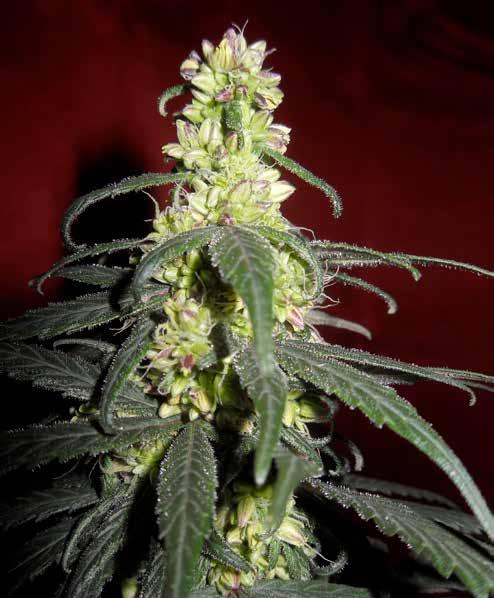

Intersex (AKA hermaphrodite) plants inherit genes that trigger both male and female flowers on the same plant. Environmental stress promotes more pronounced intersex characteristics in plants. However, intersexuality is the product of genetics and is passed on from one generation to the next. Cannabis can demonstrate a high or a low degree of intersexuality. The ratio of male to female flowers varies according to genetic makeup. In some cases, intersexuality is very pronounced; many male and female flowers grow on the same plant. Other times just a few male flowers grow on a predominately female plant. A few male flowers on an intersex plant are difficult to find. A single intersex male flower can pollinate female flowers and produce many, many seeds. Intersex plants are very, very poor choices for a breeding program. Intersex plants are often called by the misnomer “hermaphrodite.”


Ducksfoot is a webbed leaf variety that originated in Australia. Leaves are joined together along the base rather than connecting at the petiole. Even though leaves edges are serrated, the odd shape does not look like the classic cannabis leaf. The webbed leaf characteristic is dominant and carries through to offspring when crossed. Due to Ducksfoot´s low cannabinoid profile it is usually crossed with more potent varieties that are commercially available.

Fasciation, AKA cresting, is a relatively rare condition that manifests as an extra tissue growth on an elongated female flower, typically at the tip (apical meristem) of the tallest flower. The multiple flowers grow and become flattened and elongated, growing into a thick flat ribbon-like or “crested” contorted shape. The flowers are generally heavier than normal with an exaggerated number of stigmas. Fasciation can occur in any part of the plant – leaves, stems, and roots.


Flowers on leaves, AKA leaf buds and piggyback buds, are a relatively common mutation. Flower buds grow at the base of leaf blades where they connect to the petiole. Although interesting, flowers are extremely small and difficult to manicure. You may find it easiest to remove the mutated leaves so that plants can focus on growing big flowers.

Stringy flowers separated from one another form along stems. The well-known cultivar, ´Dr. Grinspoon´ is the best example of stringy flowers. Sativa varieties originating in Southeast Asia and slow to mature. Production is low and ratios of intersexuality are high. Aromatic and fun psychoactive qualities make these varieties worth all the hassle.

Trifoliate plants are somewhat common. Three sets of leaves and branches grow instead of two opposing sets. They will pop up occasionally when growing unstable seed. Trifoliate mutations should be removed from the garden because they have a very high tendency to grow into male plants and plants with intersex (both male and female) flowers.

This variety named Magnus got its wires crossed. The result of releasing a seed variety before it has been completely tested and proven. The leafy sporadic growth grows small flowers.

Dr. John McPartland (Hemp Diseases and Pests) calls the plants a “morphological chimera”. A chimera is a plant that contains cells from two or more plants. The cells contain the DNA of two or more plants. Professional breeders are interested in chimera mutations to expand into the ornimal plant market. Most growers weed out these plants because they set small leafy flowers with low levels of cannabinoids. I always cull them out.

This plant showed up as a volunteer in my Northern California garden. As you can see, the branching is very dense and so is the leaf formation. The plant never produced descent flowers. They were all small, not to resinous and difficult to harvest around the leafy foliage.
This article is supported by the Cannabis Encyclopedia, ¡¡FREE!! in Eleven (11) languages –Czech, Dutch, English, French, Italian, Japanese, German, Portuguese, Russian, Spanish, and Ukrainian at, www.marijuanagrowing.com.
Award-Winning cannabis cultivation author Jorge Cervantes teams up with Seedsman for a FREE, comprehensive digital book on home growing.
100-page digital book
270+ color images
Interactive – Searchable
Comprehensive guide to cannabis cultivation


Beginner and advanced growers
Easy-to-follow cultivation examples
8 chapters of cultivation wisdom
Dedicated to increasing cannabis yields
Discover the magic of cannabis!
www.marijuanagrowing.com/grow-cannabis-book
Co-Authors
Chief Scientific Officer, Dr. Gary Yates
Stefan Meyer
Table of Contents
• Cannabis Botany
• Life Cycle of Cannabis
• Cannabis Seeds & Seedlings
• Plan Your Garden
• Grow Room Setup
• Twelve-week Garden
• Harvest, Manicuring, Drying, Curing & Storage
• Diseases, Pests & Problems

Author Marijuana Horticulture.
Legendary Jorge Cervantes, published in eight languages sold over a million copies worldwide.

Text: Derrick Bergman / Gonzo Media

When Jay-Z, probably the world’s most famous rapper, launched his own cannabis brand in 2020, he and his business partners were full of confidence. Monogram would dominate the Californian market. More than four years later, the company and the $575 million that investors put into it seem to have gone up in smoke.
“Pride comes before a fall,” the saying goes, and that certainly applies to Monogram, a name that Jay-Z reportedly came up with himself. Take the mission, as it still states on the website: “Monogram marks a new chapter in cannabis, defined by dignity, care and consistency, it is a collective effort to bring you the best, and a humble pursuit to discover what the best really means.”
‘We will dominate the market’ Nice words, but it was mainly about dollars. Behind Monogram was The Parent Company, usually abbreviated as TPCO, a merger of three cannabis companies. In 2020, TPCO owned twenty cannabis brands, from Carlos Santana’s Mirayo to Marley Natural, several cultivation facilities and a network of weed shops in California. Michael Aurbach, a member of the board of directors, said in 2020: “We’re going
to dominate and consolidate the market. It’s going to be hard for any small player to compete with us.”
Of the $575 million that TPCO had in cash at the time, nothing remains, the California news website SFGate reported in early December 2024. TPCO has merged with yet another cannabis company, which is also in financial trouble. The Monogram website states that its cannabis products are for sale at eight stores in California and one store in Arizona. But none of these nine stores have anything Monogram on the menu, SFGate revealed. Painful.
Artisan Rollers
In the news coverage about Monogram, one product keeps coming up: a $50 pre-rolled joint (€48.58). This ‘OG Handroll’ contains 1.5 grams of weed and is – according to Monogram –hand-rolled by ‘well-trained, artisan rollers’ who crumble the weed by hand. To roll the joints, they use ‘a time-honored technique specially designed by Monogram’s Culture and Cultivation Ambassador, DeAndre Watson’.
Monogram’s cannabis strains, a la Chanel, don’t have names, but numbers: No01, No03 and
No96. These three strains cost the same: $40 for a two-gram jar (€19.50 per gram) or $70 for a four-gram jar (€17.06 per gram). These are steep prices. Especially in California, where the price of cannabis products is under great pressure and illegal suppliers still have a large market share. Only forty percent of California municipalities allow retail stores.
Anyone who tries to sell weed for almost $20 per gram and joints for over $48 each in such a market is setting themselves up for failure.
In 2021, GQ magazine visited “Jay-Z’s Weed Factory” in San Jose, California. A facility of over 92,000 square meters, with an annual production of about five thousand kilos of cannabis. The reporter is shown around by DeAndre Watson, who flies from Los Angeles to San Jose every week to check on the plants.
When the reporter confesses that her OG Handroll looked rather lumpy and kept going out after a few seconds, Watson assures her that that is precisely the point. The papers are “individually crinkled by hand so that they burn more evenly” and the weed is not finely ground, but divided into “mini pearls.” This
makes smoking a joint “a prolonged, unhurried experience where you light, let it go out, and light again,” Watson says.
That sounds a bit like promoting a cold, tough steak as a culinary discovery where you experience a new taste experience through enhanced chewing and lowered temperatures. The demise of Monogram, despite half a billion dollars and the most famous rapper on the planet as its poster boy, proves that celebrity branding has its limits. And perhaps also that cannabis consumers can’t be fooled by fancy talk but mediocre products at sky-high prices.
Monogram’s website is still online as of mid-January 2025. Monogram and Jay-Z have left TPCO, SFGate reported: “In December 2022, Monogram officially separated from TPCO and is now owned by a separate public company,
TO
WEED FOR ALMOST $20 PER GRAM AND JOINTS FOR OVER $48 EACH IN SUCH A MARKET IS SETTING THEMSELVES UP FOR FAILURE.
according to stock information from Gold Flora.” That company still has the exclusive right to sell Monogram products in California. It’s unclear when Gold Flora stopped selling; the company did not respond to questions from SFGate.
Jay-Z has other things on his mind now. A 38-year-old woman accused him in early December 2024 of raping her in 2000. Through his lawyer, Jay-Z has denied the accusation. To unwind, the rapper can smoke his own weed or drink a glass of SirDavis, the whiskey that his wife Beyoncé launched last year.
Robert B.

First of all, a distinction should be made between hemp seed oil and hemp resin oil. The first is a food product extracted from hemp seeds, which in turn contain no psychoactive substances. In the past, the
only psychoactive effects from hemp seed oil were due to seed incrustations that fell into the oil during pressing. By using the right type of hemp grown for fibre or washing the hemp seeds, this no longer occurs.

Psychoactive hemp oil with cannabinoids as active ingredients, on the other hand, is obtained from the flower parts close to the seeds. Sinsemilla flowers do not even contain hemp seeds. To be more precise,
one should speak about hemp resin oil. The term ‘hemp oil’ leads to a lot of confusion.
Many vegetable oils are not suitable for frying or deep-frying because they break down due to the action of heat. Their valuable nutritional properties are partially or completely lost and the heat also favours the production of carcinogenic substances. In addition, each vegetable oil has a specific boiling point. If the wrong vegetable oil is used, the boiling point is lower and if the oil boils, the risk of fire is higher. Just being in the kitchen with boiling vegetable oil can be harmful to the respiratory tract. For this reason, a CBD extract dissolved in vegetable oil should not be smoked or drunk. The inhalation of boiled vegetable oils is not recommended. Essential oils (and other suitable oils) are only recommended for this use.
Many components of hemp resin oil also have low boiling points and volatilise quickly. Some terpenes, which are essential components of the smell and taste, volatilise even at high room temperatures. Many consumers first look at the THC content of the oil. This active ingredient, which makes you high, has a boiling point of around 157° Celsius. CBD – preferred by another category of consumers – boils at 160 to 180° Celsius. CBN boils at 185° Celsius and THCV at 220° Celsius. At this maximum temperature level, marijuana eventually burns. So even hemp resin oil should not be heated too much. However, most of THC (or CBD) content is present only in precursor form (i.e.,




With active ingredients, the cookies stand would be sold out.
THCA and CBDA), which will not have the desired effect in the body. These acids are converted into absorbable active substances by the effect of heat at 80 to 140° Celsius. This process is called ‘decarboxylation’. It is quite possible to heat a starting material for 20 to 120 minutes. With less time of exposure, a higher temperature should be chosen and vice versa. In a burning joint, 2 seconds are enough.
This is why heating before actual consumption is very important. However, too much or too long heat can have a counterproductive effect and break down THC.
Those who are after the psychoactive effects of THC should know that it continues to change when exposed to oxygen and no longer has its original effect. Therefore, the starting material should only be heated shortly before consumption and protected from oxygen. For oral intake, it should also be considered that hemp resin oil is not water-soluble, and it is therefore advisable to dissolve it in fats or other carriers. The reason why butter is always used when baking brownies is that it favours the absorption of active ingredients through digestion.
It has always been known that hemp seed oil is not suitable for frying because it does not tolerate high temperatures. That is why, more recently, during the cooking shows at the Cultiva and Cannabis XXL hemp fairs, visitors asked how to cook, fry and bake properly with hemp seed oil. Among the answers that are worth recalling, more or less in the same vein, Danny Wagenfeld said that hemp seed oil in the kitchen should only be used for baking and frying at a low temperature. When making hemp
butter, a maximum of 80° Celsius should be considered, otherwise the maximum recommended limit is 140° Celsius. If you do not know how hot the oil is when frying, you should not use hemp seed oil and also avoid wasting it. When baking, however, the temperature can be adjusted very precisely and, therefore, handling hemp seed oil or hemp resin oil safely is no problem at all. However, those who consume THC-rich hemp resin oil in food run the risk of an unpleasant overdose lasting for hours, which drops sooner if the oil is just inhaled. Since the effect of inhaling starts after minutes, and not after 30 or 60 minutes as is the case for food, the dosage can be safer.
Due to the contained polyunsaturated fatty acids omega 3 and omega 6 in a ratio of 1 to 3, hemp seeds or hemp seed oil are very healthy. The optimal ratio for human consumption of these omega fatty acids –to be constantly supplied with food as the human body cannot produce them on its own – is 1 to 4. A deficiency – which would have to be avoided through the regular intake of these acids in the diet – can have negative consequences for health. That is why many people eat fish oil capsules containing these fatty acids, which is not good for the already overfished oceans, as the ratio of 1 to 4 is not even close to being reached with many omega-3 and omega-6 supplements.
Hemp seeds can be obtained ecologically directly through home growing. Both the seeds and the oil extracted from them are tasty. Everything depends not so much on the quantity but on the regularity and freshness of hemp seed oil. Hemp seeds and hemp seed oil should always come from the harvest of the current or previous year. If you open a bottle, after a few weeks of exposure to oxygen, this oil will lose its qualities, which will also be destroyed by the effect of light. Therefore, small brown glass bottles or sealed containers are preferable for quick consumption. It is then sufficient to consume about one tablespoon of hemp seed oil per person per day to be able to safely exclude a deficiency. Presumably, even a teaspoonful of this valuable nutrient would suffice.
Despite their infinitesimally small amount, these omega 3 and 6 fatty acids are significant for health. Those who constantly consume fresh hemp seeds or fresh hemp seed oil are on average less frequently or less severely affected by diseases, and their life expectancy increases. These fatty acids can also positively impact on mental illnesses and thus significantly increase wellbeing. But I will stop there. Further details would go beyond the scope of this article. So far, research has not been comprehensive and, therefore, no exact statements can be made. The negative effects of hemp seed oil are apparently nonexistent. It will only do you good, not harm.
Hemp seed oil can be used for baking, steaming and salad seasoning. Many people simply eat a spoonful every day. Consuming hemp seed oil pure is only a matter of taste. You can also mix your daily muesli with hemp seeds in a proportion of 1 to 1. Even then, the hemp seed oil will be absorbed by your body.
Soft Secrets is published by Discover Publisher BV
Galvaniweg 11, 5482 TN Schijndel, Netherlands
Telephone: +31(0)73 5498112
E-mail: info@softsecrets.nl
Web: www.softsecrets.com
Editor: Cliff Cremer
Contributors: Stoney Tark Jorge Cervantes, Ed Rosenthal, Mr. José, Green Born Identity (G.B.I.), TricomaTeam, Tommy L. Gomez, Fabrizio Dentini, Olivier F., Hortizan, Derrick Bergman/Gonzo Media and others.
Photography: iStock, Unsplash
Editorial adress:
E-Mail: readers@softsecrets.nl
Advertisements:
E-Mail: info@softsecrets.nl
Distributed throughout Denmark, Finland, Georgia, Germany, Greece, The Netherlands, Malta, Slovenia, Spain, Switzerland, Thailand, United Kingdom (England and Ireland).
A word from the publisher: World wide there is a process going on of relative liberalisation towards the use of cannabis, be it for medicinal or recreational purposes. Several countries legalised cannabis as a way of separating soft and hard drugs, as it has proven to do in Holland. Other countries legalised the use of medicinal cannabis, including the right to grow cannabis plants for one’s own use. The publisher wants to highlight the process of normalisation of cannabis use. This assumes that the publisher does not necessarily agree with everything that appears in articles and advertisements. The publisher therefore distances himself explicitly from published statements or images that might give the impression that an endorsement is being made for the use and/or production of cannabis.
Nothing from this publication may be copied or reproduced in any format without prior permission from the publisher and other copyright holders. The publisher is not responsible for the content and/or point of view of advertisements. The editor takes no responsibility for unsollicited submissions.
The publisher has endeavored to reach all copyright holders of photos and/or images. Those who still believe they are entitled to these rights may contact the publisher.
Next issue out


















































